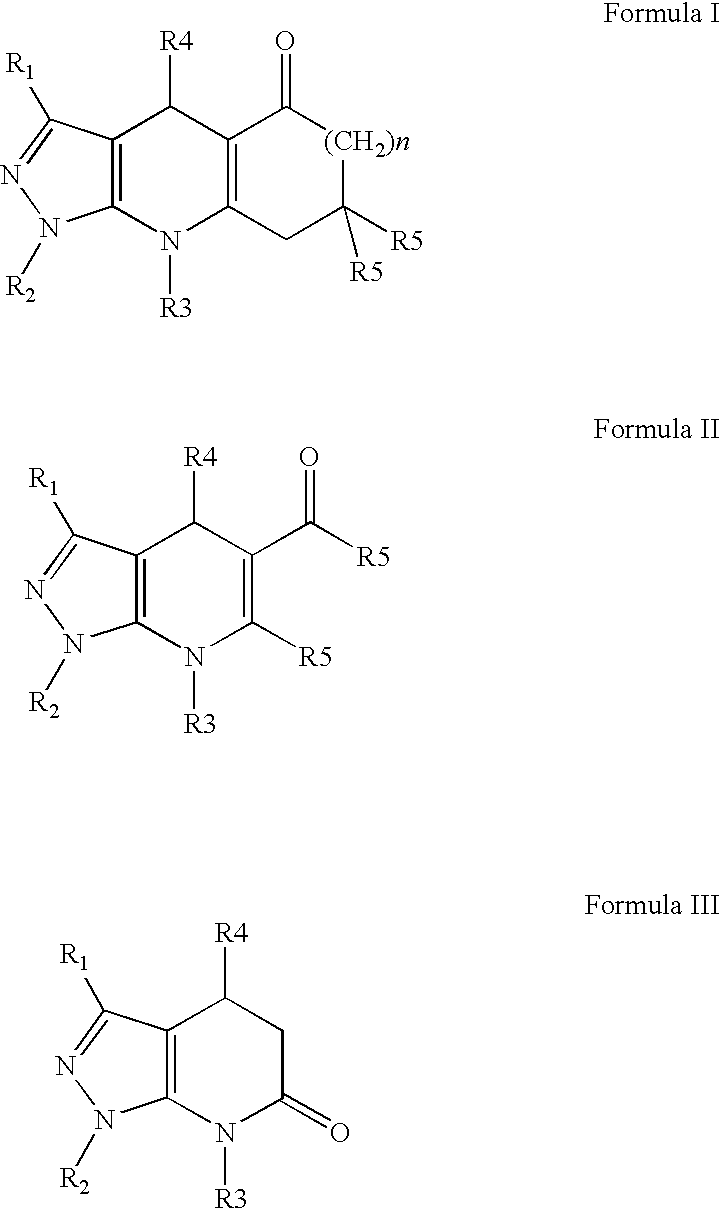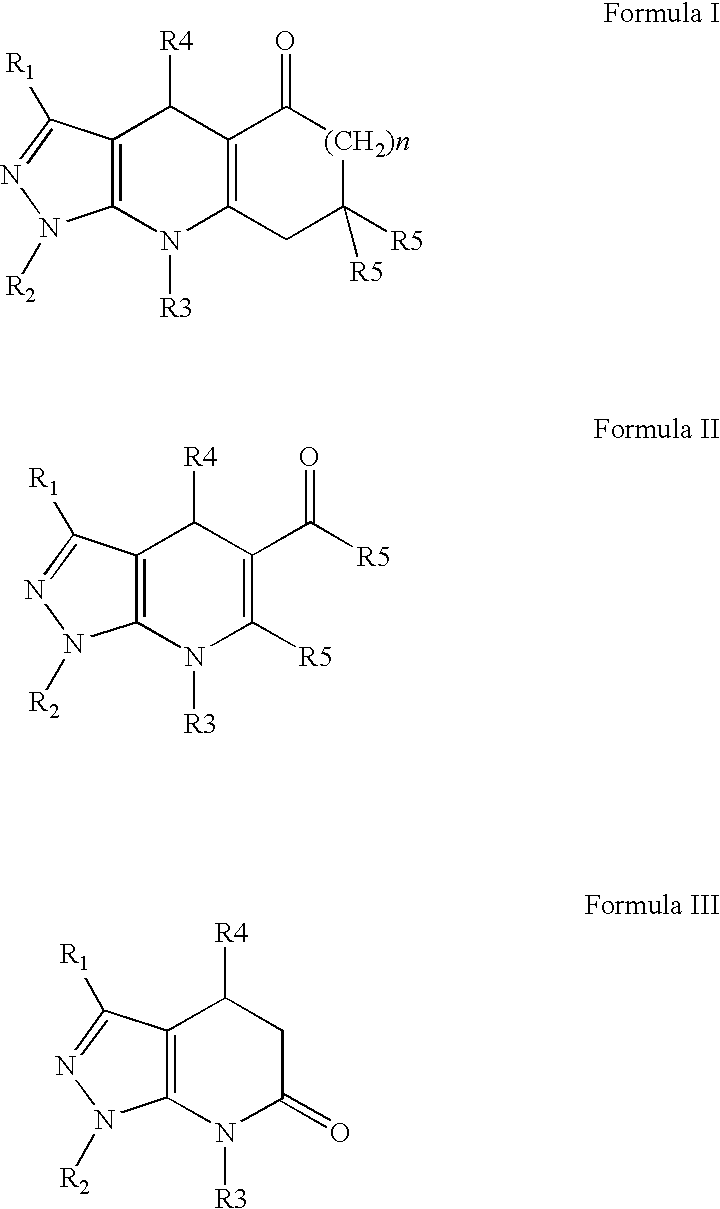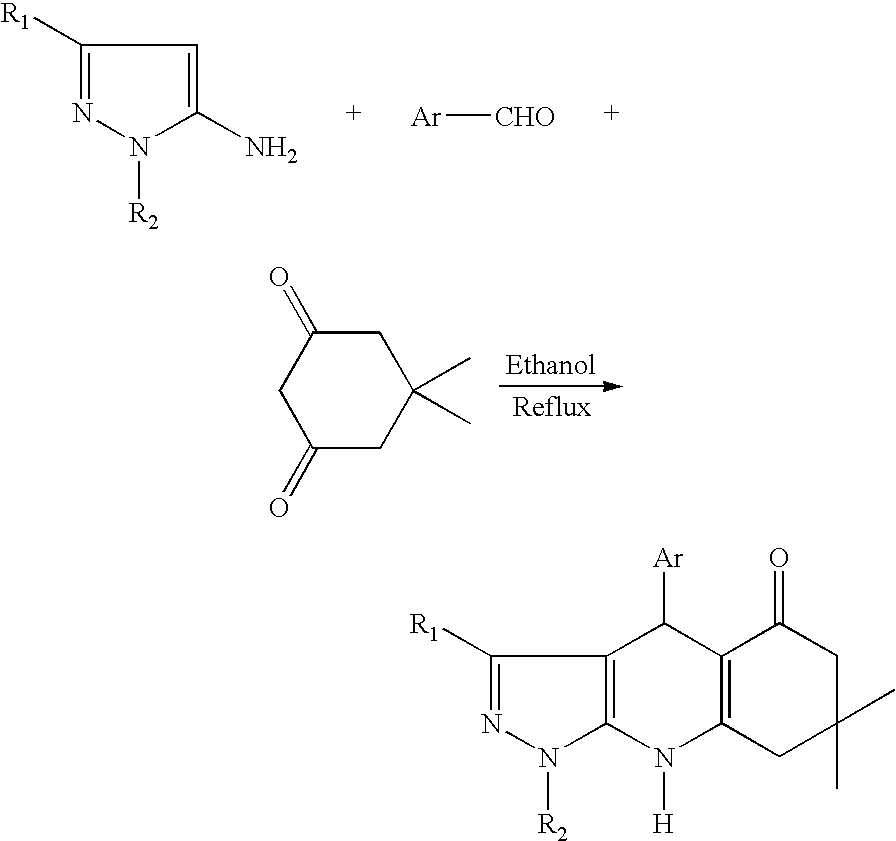Compounds having inhibitive activity of phosphatidylinositol 3-kinase and methods of use thereof
a technology of phosphatidylinositol 3-kinase and compounds, which is applied in the field of inhibitors of pi 3k activity, can solve the problems of poor selectivity and limited utility of these compounds in studying the roles of individual class i pi 3-kinases
- Summary
- Abstract
- Description
- Claims
- Application Information
AI Technical Summary
Benefits of technology
Problems solved by technology
Method used
Image
Examples
example 1
Synthesis and Characterization of 964076 3-t-butyl-4-(2-chlorophenyl)-7,7-dimethyl-1-(4-methoxyphenyl)-4,7,8,9-tetrahydro-1H-pyrazolo[3,4-b]quinolin-5(6H)-one
[0107]
[0108] The reaction vessel was charged with 1-(4-methoxyphenyl)-3-t-butyl-5-aminopyrazole (500 mg, 2.03 mmol) dissolved in ethyl alcohol (20 mL). Then, (2-chloro-benzaldehyde (218 mL, 2.43 mmol) and dimedone (285 mg, 1.0 mmol) were added to the above solution while stirring at room temperature. The reaction mixture was heated to 80° C. and refluxed for 6 h.
[0109] The reaction vessel was then cooled to room temperature, and the solvent was removed under reduced pressure on a rotary evaporator. The residue was triturated with n-hexane in order to induce crystallization. The solid product was re-dissolved and further purified by column chromatography yielding a pure product (110 mg) which was then characterized by NMR:
[0110] 1H NMR (CDCl3): 0.8, 1.02, 1.1, 1.23, 2.03, 2.14, 3.85, 5.67, 6.32, 7.02, 7.14, 7.23, 7.44.
example 2
Synthesis and Characterization of 964028 3-t-butyl-4-(4-methylphenyl)-7,7-dimethyl-1-(4-methylphenyl)-4,7,8,9-tetrahydro-1H-pyrazolo[3,4-b]quinolin-5(6H)-one
[0111]
[0112] The reaction vessel was charged with l-(4-methylphenyl)-3-t-butyl-5-aminopyrazole (180 mg, 0.78 mmol) dissolved in ethyl alcohol (10 mL). A p-tolualdehyde (110 mg, 0.94 mmol) and dimedone (110 mg, 0.78 mmol) were then added to the above solution while stirring at room temperature. The reaction mixture was heated to 80° C. and refluxed for 6 h. The reaction vessel was then cooled to room temperature, and the solvent was removed under reduced pressure on a rotary evaporator. The residue was triturated with n-hexane in order to induce crystallization. The solid product (178 mg) was filtered off, washed and dried under ambient conditions which was then characterized by NMR: 1H NMR (CDCl3): 0.82, 1.03, 1.14, 1.23, 2.25, 2.41, 5.40, 6.22, 7.00, 7.18, 7.31, 7.43.
example 3
Synthesis and Characterization of 1,3-Di-t-butyl-4-p-trifluoromethylphenyl-1,4,5,7-tetrahydro-pyrazolo[3,4-b]pyridin-6-one
[0113]
[0114] The reaction vessel was charged with 1,3-di-t-butyl-5-aminopyrazole (50 mg, 0.26 mmol) dissolved in ethyl alcohol (5 mL). p-trifluoromethylbenzaldehyde (44.6 mg, 0.26 mmol) and Meldrum's acid (36 mg, 0.26 mmol) were then added to the above solution while stirring at room temperature. The reaction mixture was heated to 80° C. and refluxed for 6 h. The reaction vessel was then cooled to room temperature, and the solvent was removed under reduced pressure on a rotary evaporator. The residue was purified by chromatography over silica, eluting with a mixture of hexanes and ethyl acetate. The solid product (70 mg) was isolated then characterized by NMR.: 1H NMR (CDCl3):1.12, 1.59, 2.67, 3.12, 4.40, 7.14, 7.51, 8.23.
PUM
| Property | Measurement | Unit |
|---|---|---|
| Composition | aaaaa | aaaaa |
Abstract
Description
Claims
Application Information
 Login to View More
Login to View More - R&D
- Intellectual Property
- Life Sciences
- Materials
- Tech Scout
- Unparalleled Data Quality
- Higher Quality Content
- 60% Fewer Hallucinations
Browse by: Latest US Patents, China's latest patents, Technical Efficacy Thesaurus, Application Domain, Technology Topic, Popular Technical Reports.
© 2025 PatSnap. All rights reserved.Legal|Privacy policy|Modern Slavery Act Transparency Statement|Sitemap|About US| Contact US: help@patsnap.com



